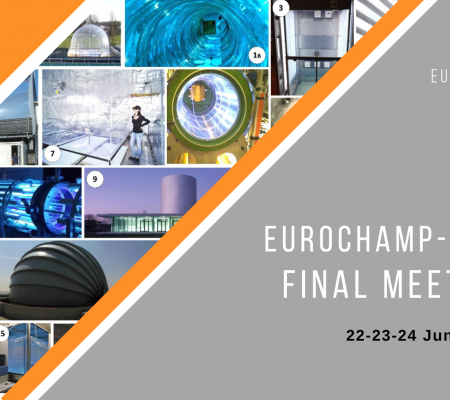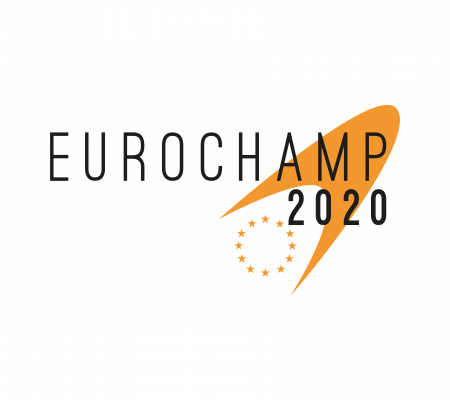| General information | |||||||||||||||||||||||||||||||||||||||||||
| Access mode | Physical access | ||||||||||||||||||||||||||||||||||||||||||
| Infrastructure name and acronym | Quartz Reactor (QUAREC) | ||||||||||||||||||||||||||||||||||||||||||
| Photos |
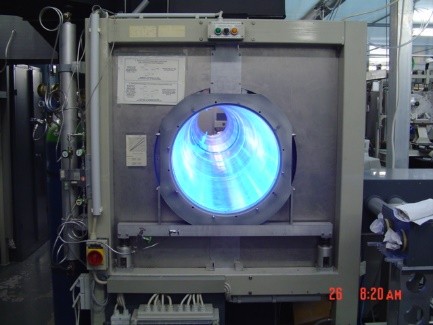 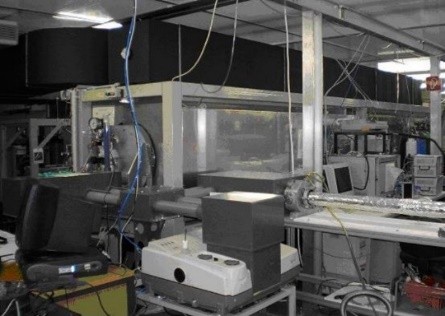 |
||||||||||||||||||||||||||||||||||||||||||
| Location | Wuppertal, Germany | ||||||||||||||||||||||||||||||||||||||||||
| Website |
http://www.ptc.uni-wuppertal.de/forschung/atmosphaerenchemie.html; http://www.ptc.uni-wuppertal.de/forschung/atmosphaerenchemie/laborstudien.html |
||||||||||||||||||||||||||||||||||||||||||
| Legal name of organisation operating the infrastructure | 51.2562° N, 7.1508° E Bergische Universität Wuppertal Gemany |
||||||||||||||||||||||||||||||||||||||||||
| Description of the infrastructure | |||||||||||||||||||||||||||||||||||||||||||
| Brief general description of the infrastructure to which access is offered |
The QUAREC reactor consists of two quartz cylinders with an inner diameter of 0.47 m and a total joined length of 6.2 m. The chamber is closed at both ends by aluminium flanges which contain numerous inlet and outlet ports for the introduction of bath gases and chemicals. A pumping system consisting of a turbo-molecular pump backed by a double stage rotary fore pump allows the photoreactor to be evacuated to 10-3 Torr. Magnetically coupled Teflon mixing fans are mounted inside the chamber to ensure homogeneous mixing of the reactants. Two types of lamps are available for photolysis of the radical/atom precursors: 32 super actinic fluorescent lamps (Philips TL 05/40 W: 320<λ<480 nm, λmax=360 nm) and 32 low-pressure mercury lamps (Philips TUV/40W, λmax=254 nm). The lamps are distributed evenly around the photoreactor, are wired in parallel, and can be switched by pairs. A White type multiple-reflection mirror system with a total optical path length of 484.7 ± 0.8 m is mounted inside the photoreactor for sensitive in situ long path absorption monitoring of reactants and products in the IR spectral range 4000 – 700 cm-1. IR spectra are usually recorded with a spectral resolution of 1 cm-1 using a Thermo IS50 Advanced FT-IR spectrometer equipped with a KBr beam splitter and a liquid nitrogen cooled mercury-cadmium-telluride (MCTA) detector. The reactor can be actually operated at room temperature (293±4 K). A new temperature control unit (255 – 330 K) will be available within the fourth quarter of 2020. Apart from FTIR spectrometry a GC-MS/FID system, LOPAP and monitors for the detection of NOx, O3 and HONO are also available and can be attached to the reactor. |
||||||||||||||||||||||||||||||||||||||||||
| Services currently offered by the infrastructure and its research environment | Investigations of gas-phase photooxidation processes including: - Determination of rate coefficients for the reactions of OH, NO3 halogens and ozone with VOCs - Product analysis of the radical or ozone mediated photooxidation of VOCs - Help in the elucidation of VOC degradation mechanisms |
||||||||||||||||||||||||||||||||||||||||||
| Modalities of access and support offered under EUROCHAMP-2020 | |||||||||||||||||||||||||||||||||||||||||||
| Typical duration of work |
Two to three weeks |
||||||||||||||||||||||||||||||||||||||||||
| Community/user type served |
QUAREC is mainly used for research and training projects |
||||||||||||||||||||||||||||||||||||||||||
| Scientific and technical support offered |
Guidance in the planning and assistance in performing and evaluating the experiments performed in QUAREC. A technician is permanently on site to ensure the smooth operation of the facility. |
||||||||||||||||||||||||||||||||||||||||||
| Logistic and administrative support offered |
Assistance is given with the bath gases necessary for the experiments and also the ordering of chemicals (if desired). If requested assistance in finding accommodation for the duration of the TNA will be provided. |
||||||||||||||||||||||||||||||||||||||||||
| Person in charge of access provision at the infrastructure | Person in charge of access provision at the infrastructure: Prof. Peter Wiesen (wiesen@uni-wuppertal.de) and/or Dr. Iulia Patroescu-Klotz (patroescu@uni-wuppertal.de) | ||||||||||||||||||||||||||||||||||||||||||
| Extended technical information | |||||||||||||||||||||||||||||||||||||||||||
| Physical description | The QUAREC chamber is made of 2 quartz glass tubes with metal end flanges Volume: 1080 litres (1.08 m3) Diameter: 0.47 m Length: 6.2 m Total Surface Area: 9.5 m2 Lateral Surface Area: 9.15 m2 End Flange Surface Area: 2 x 0.173 m2 Surface-to Volume Ratio: 8.79 m-1 Temperature range: 298 ±5 K Pressure range: 762±10 Torr RH range: ≤ 1 % 4) |
||||||||||||||||||||||||||||||||||||||||||
| List of instruments |
|
||||||||||||||||||||||||||||||||||||||||||
| Mechanical description (schematic) | 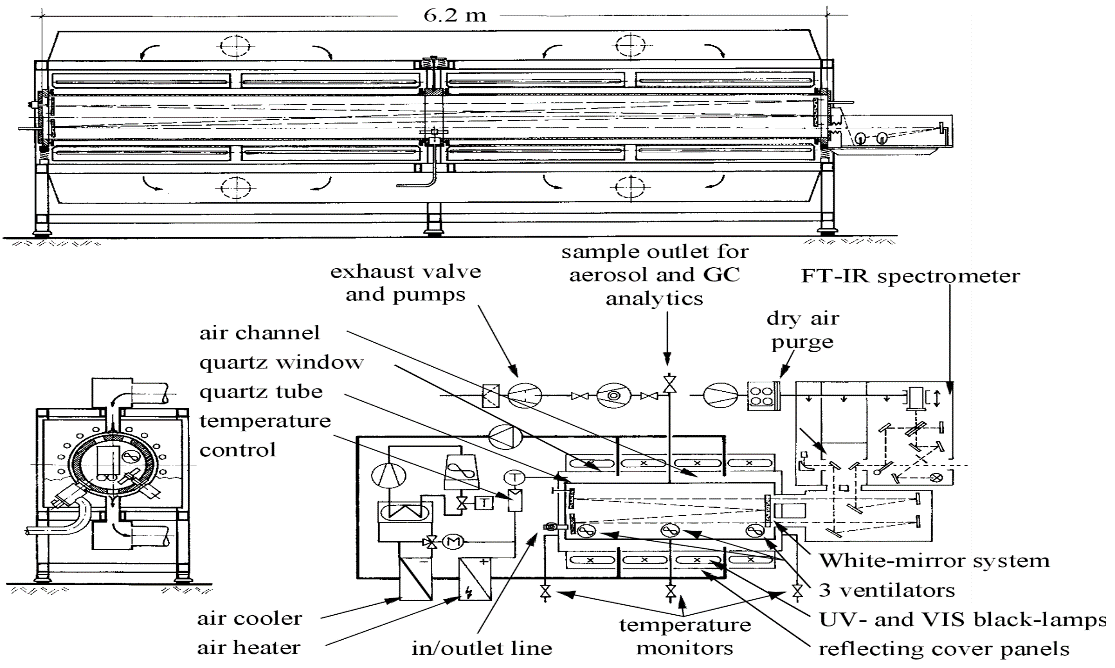 |
||||||||||||||||||||||||||||||||||||||||||
| Mechanical description | Limited mechanical information is available on request | ||||||||||||||||||||||||||||||||||||||||||
| Irradiation spectra | 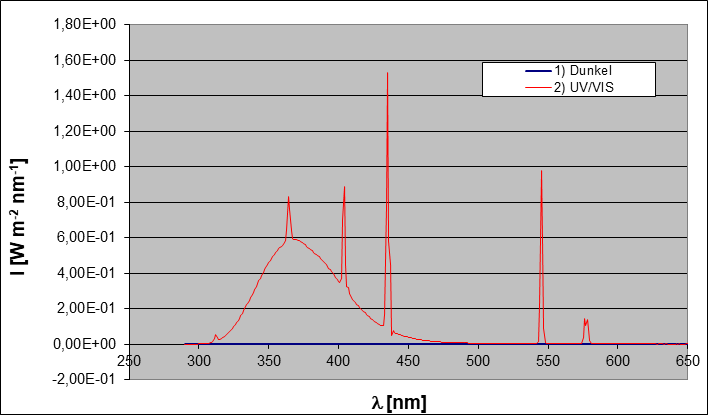 |
||||||||||||||||||||||||||||||||||||||||||
| Auxiliary mechanism |
|
||||||||||||||||||||||||||||||||||||||||||
| Description paper |
I. Barnes, K.H. Becker and N. Mihalopoulos, An FTIR Product Study of the Photooxidation of Dimethyl Disulfide. |
||||||||||||||||||||||||||||||||||||||||||



